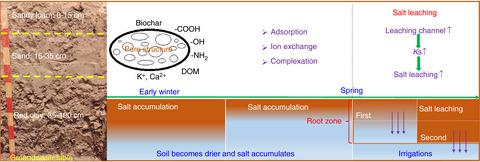当前位置:
X-MOL 学术
›
Soil Use Manag.
›
论文详情
Our official English website, www.x-mol.net, welcomes your
feedback! (Note: you will need to create a separate account there.)
Evaluating the effect of biochar on salt leaching and nutrient retention of Yellow River Delta soil
Soil Use and Management ( IF 5.0 ) Pub Date : 2020-08-31 , DOI: 10.1111/sum.12638 Liang Xiao 1, 2 , Fande Meng 3
Soil Use and Management ( IF 5.0 ) Pub Date : 2020-08-31 , DOI: 10.1111/sum.12638 Liang Xiao 1, 2 , Fande Meng 3
Affiliation

|
Biochar has the potential to decrease salinity and nutrient loss of saline soil. We investigated the effects of biochar amendment (0–10 g kg−1) on salinity of saline soil (2.8‰ salt) in NaCl leaching and nutrient retention by conducting column leaching experiments. The biochar was produced in situ from Salix fragilis L. via a fire‐water coupled process. The soil columns irrigated with 15 cm of water showed that biochar amendment (4 g kg−1) decreased the concentration Na+ by 25.55% in the first irrigation and to 60.30% for the second irrigation in sandy loam layer over the corresponding control (CK). Meanwhile, the sodium adsorption ratio (SAR) of soil after the first and second irrigation was 1.62 and 0.54, respectively, which were 15.2% and 49.5% lower than CK. The marked increase in saturated hydraulic conductivity (Ks) from 0.15 × 10–5 cm s−1 for CK to 0.39 × 10–5 cm s−1, following 4 g kg−1 of biochar addition, was conducive to salt leaching. Besides, biochar use (4 g kg−1) increased NH4+‐N and Olsen‐P by 63.63% and 62.50% over the CK, but accelerated NO3–‐N leaching. Since 15 cm hydrostatic pressure would result in salt accumulation of root zone, we would recommend using 4 g kg−1 of biochar, 30 cm of water to ease the problem of salt leaching from the surface horizon to the subsoil. This study would provide a guidance to remediate the saline soil in the Yellow River Delta by judicious application of biochar and irrigation.
中文翻译:

评价生物炭对黄河三角洲土壤盐分淋失和养分保留的影响
生物炭具有降低盐碱土壤盐分和养分流失的潜力。通过进行柱浸试验,我们研究了生物炭改良剂(0-10 g kg -1)对盐溶液(2.8‰盐)中盐分盐分的NaCl淋洗和养分保留的影响。该生物炭是通过火水耦合工艺从脆弱柳(Salix fragilis L.)原位生产的。用15厘米水灌溉的土壤柱显示,生物炭改良剂(4 g kg -1)降低了Na +的浓度相对于对照(CK),沙壤土层的第一次灌溉增加了25.55%,第二次灌溉增加了60.30%。同时,第一次和第二次灌溉后土壤的钠吸附率(SAR)分别为1.62和0.54,分别比CK低15.2%和49.5%。添加4 g kg -1的生物炭后,饱和水导率(K s)从CK的0.15×10 –5 cm s -1显着增加到0.39×10 –5 cm s -1,这有利于盐的浸出。此外,生物炭的使用(4 g kg -1)比CK分别增加了NH 4 + -N和Olsen-P 63.63%和62.50%,但促进了NO 3 –‐N浸出。由于15 cm的静水压力会导致根部区域盐分积聚,因此我们建议使用4 g kg -1的生物炭,30 cm的水,以缓解盐分从地表到底土的淋溶问题。这项研究将为通过合理应用生物炭和灌溉来修复黄河三角洲的盐渍土壤提供指导。
更新日期:2020-10-22
中文翻译:

评价生物炭对黄河三角洲土壤盐分淋失和养分保留的影响
生物炭具有降低盐碱土壤盐分和养分流失的潜力。通过进行柱浸试验,我们研究了生物炭改良剂(0-10 g kg -1)对盐溶液(2.8‰盐)中盐分盐分的NaCl淋洗和养分保留的影响。该生物炭是通过火水耦合工艺从脆弱柳(Salix fragilis L.)原位生产的。用15厘米水灌溉的土壤柱显示,生物炭改良剂(4 g kg -1)降低了Na +的浓度相对于对照(CK),沙壤土层的第一次灌溉增加了25.55%,第二次灌溉增加了60.30%。同时,第一次和第二次灌溉后土壤的钠吸附率(SAR)分别为1.62和0.54,分别比CK低15.2%和49.5%。添加4 g kg -1的生物炭后,饱和水导率(K s)从CK的0.15×10 –5 cm s -1显着增加到0.39×10 –5 cm s -1,这有利于盐的浸出。此外,生物炭的使用(4 g kg -1)比CK分别增加了NH 4 + -N和Olsen-P 63.63%和62.50%,但促进了NO 3 –‐N浸出。由于15 cm的静水压力会导致根部区域盐分积聚,因此我们建议使用4 g kg -1的生物炭,30 cm的水,以缓解盐分从地表到底土的淋溶问题。这项研究将为通过合理应用生物炭和灌溉来修复黄河三角洲的盐渍土壤提供指导。











































 京公网安备 11010802027423号
京公网安备 11010802027423号